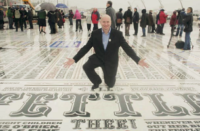The green building sector of the U.S. construction industry is slated to contribute 2.3 million jobs in 2015, growing to 3.3 million by 2018. This sector is outpacing overall construction growth in the U.S. and will account for more than 2.3 million American jobs this year, according to a new U.S. Green Building Council (USGBC) study from Booz Allen Hamilton (NYSE:BAH).
The 2015 Green Building Economic Impact Study, released by USGBC and prepared by Booz Allen, finds the green building industry contributes more than $134.3 billion in labor income to working Americans. The study also found that green construction’s growth rate is rapidly outpacing that of conventional construction and will continue to rise.
By 2018, the study finds, green construction will account for more than 3.3 million U.S. jobs–more than one-third of the entire U.S. construction sector–and generate $190.3 billion in labor earnings. The industry’s direct contribution to U.S. Gross Domestic Product (GDP) is also expected to reach $303.5 billion from 2015-2018.
"Green building is playing a massive role in the U.S. construction sector, the clean and efficient energy sector and the U.S. economy as a whole," said Rick Fedrizzi, CEO and founding chair, USGBC. "More than 2.3 million U.S. workers are taking home $134 billion annually in large part because of green building programs like LEED. Demand for green building will only continue to grow as individuals, businesses and institutions continue to prioritize sustainable approaches to the design, construction and operations of our built environment."
The new USGBC analysis also explores the multifaceted economic contribution of green construction to the U.S. economy and individual U.S. states, quantifying the economic impact of green building and LEED (Leadership in Energy and Environmental Design).
"Our research shows that green building has created millions of jobs and contributed hundreds of billions of dollars to the U.S. economy, with the construction of LEED-certified buildings accounting for about 40 percent of green construction’s overall contribution to GDP in 2015," said David Erne, Senior Associate at Booz Allen. "This industry is certainly on the rise, and aggressive growth in the green building sector is anticipated over the next four years."
In addition to national jobs, GDP and labor earnings from green building, the study projects significant growth in green building’s contribution to individual states’ tax contributions and environmental asset indicators at both the national and state levels.
Total state earnings related to LEED building construction projects are estimated to total $8.4 billion by 2018. In Texas alone, almost 1.26 million jobs in the green building sector are projected between 2015 and 2018. As a result, green building will also contribute to significant savings across energy, trash, water and maintenance costs.
The U.S. Green Building Council (USGBC) is committed to a prosperous and sustainable future through cost-efficient and energy-saving green buildings. USGBC works toward its mission of market transformation through its LEED green building program, robust educational offerings, a nationwide network of chapters and affiliates, the annual Greenbuild International Conference & Expo, the Center for Green Schools and advocacy in support of public policy that encourages and enables green buildings and communities.
Booz Allen Hamilton (NYSE: BAH) has been at the forefront of strategy and technology for more than 100 years. Today, the firm provides management and technology consulting and engineering services to leading Fortune 500 corporations, governments, and not-for-profits across the globe. Booz Allen partners with public and private sector clients to solve their most difficult challenges through a combination of consulting, analytics, mission operations, technology, systems delivery, cybersecurity, engineering and innovation expertise. With international headquarters in McLean, Virginia, the firm employs more than 22,500 people globally, and had revenue of $5.27 billion for the 12 months ended March 31, 2015.











